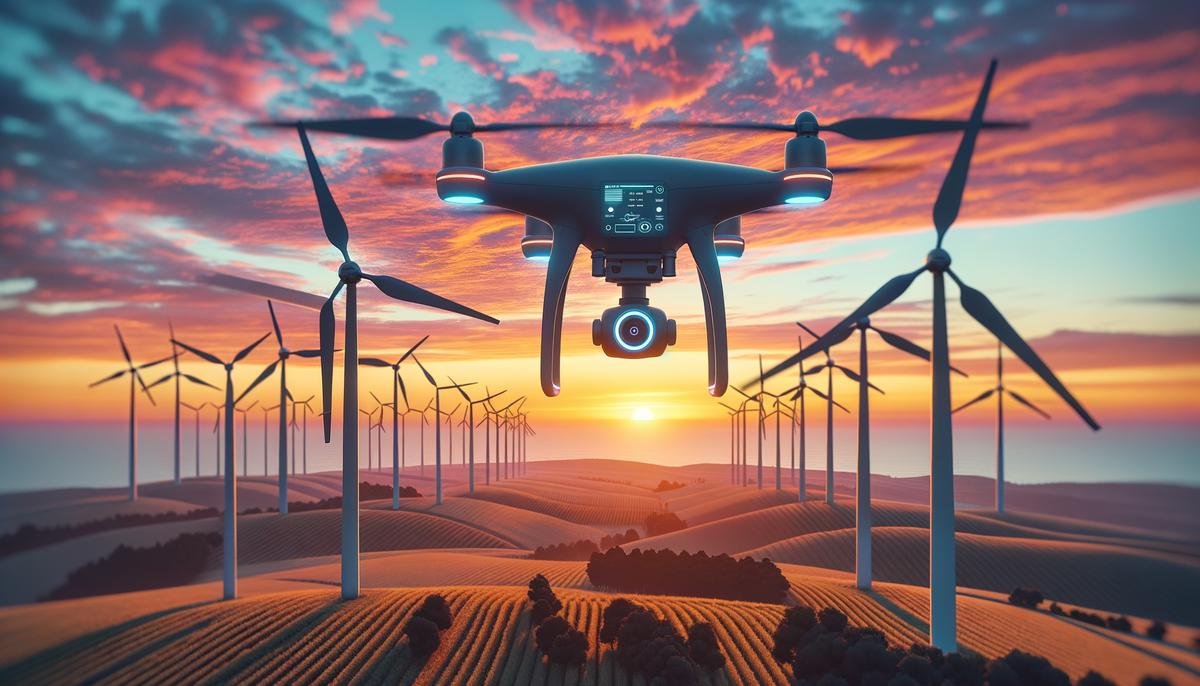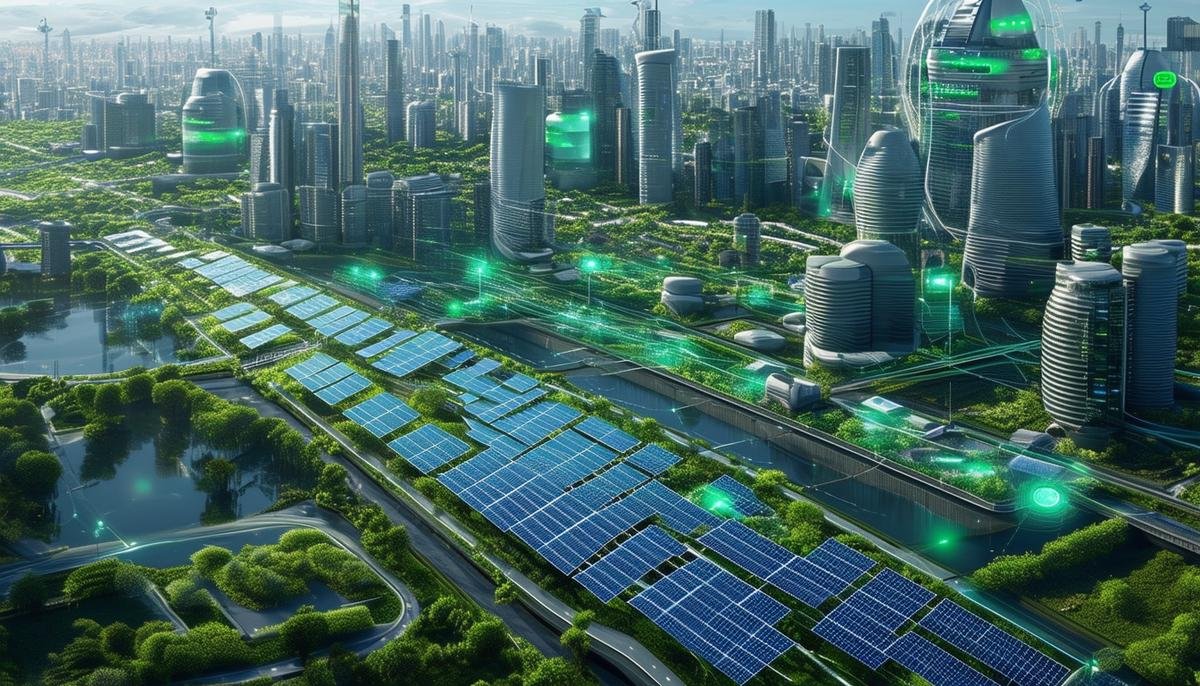AI in Climate Data Analysis
AI has reshaped how we process and analyze climate data, offering a precision that human effort alone can’t match. AI accelerates the process of identifying patterns and trends in satellite imagery significantly. It integrates data from sensors spread across vast and remote locations, gathering information on temperature, humidity, and CO2 levels, painting a coherent picture in real-time. This stream of accurate, timely data is key to predicting climate shifts.
AI models can forecast weather patterns with remarkable accuracy. Complex AI algorithms synthesize historical and real-time data, providing better forecasts. This helps communities prepare and respond effectively, reducing damage and saving lives.
For agricultural adaptation, AI identifies which crops thrive under changing climates. Analyzing data on soil quality, weather forecasts, and crop health, AI suggests optimal planting times and suitable crop varieties. This ensures farmers can maintain yields despite unpredictable conditions.
AI’s strength lies in recognizing subtle environmental changes. It can detect minute variations in iceberg sizes, more swiftly and accurately than a human eye could. This data informs scientists on the pace of glacial melt and its impact on sea levels.
Environmental monitoring benefits profoundly from AI’s capabilities. AI processes satellite images to pinpoint deforestation areas accurately. It helps governments and organizations combat illegal logging and promote reforestation.
AI’s role extends to urban planning. It analyzes data to identify vulnerable areas and predict future challenges. This allows urban planners to implement effective solutions, improving living conditions and sustainability.
Water management, crucial in drought-prone areas, gains an edge with AI. By analyzing weather data and water usage patterns, AI helps in devising efficient water distribution systems, ensuring that communities have access to this vital resource even during shortages.
AI technology can identify and mitigate methane leaks quickly, preventing thousands of tons of methane from entering the atmosphere.1 This is a vital step in reducing overall greenhouse gas emissions.
AI translates data insights into actionable advice for policymakers. They can implement regulations and mitigation strategies backed by AI-driven evidence. This synergy between data and policy accelerates efforts to combat climate change on a global scale.
AI in Predictive Climate Modeling
Predictive climate modeling is another area where AI provides significant advancements. AI surpasses the boundaries of traditional climate models, offering precision and speed unmatched by human analysis.
One of the primary applications of AI in predictive climate modeling is forecasting extreme weather events. AI algorithms can process real-time data from various sources such as satellites, weather stations, and ocean buoys. By integrating this data, AI models can identify patterns that signal an impending extreme weather event. These advanced warning systems enable timely evacuation and preparedness measures, significantly reducing the impact on human life and infrastructure.
AI also plays a crucial role in predicting solar power production. AI systems analyze historical weather data, current atmospheric conditions, and satellite images to forecast solar irradiance levels. This information helps optimize the operation of solar farms, improving energy yield predictions. Energy providers can use these predictions to balance the grid, ensuring a steady supply of clean energy and reducing the need for fossil fuel backup.
In the transportation sector, AI-driven predictive modeling aids in anticipating infrastructure demands. By studying traffic patterns, urban growth, and weather conditions, AI can forecast demand for transportation infrastructure. This helps in planning and optimizing the development of roads, public transit systems, and even bike lanes. Accurate predictions allow for more efficient use of resources and can lead to less congestion and lower emissions.
Predictive climate modeling using AI also aids in anticipating the effects of rising sea levels on coastal cities. By combining data on melting ice caps, sea surface temperatures, and historical tide patterns, AI models provide scenarios for future sea levels. City planners can use these predictions to devise adaptive strategies, such as building sea walls or modifying zoning laws to prevent construction in high-risk areas.
The ability of AI to simulate multiple climate scenarios is another transformative capability. By running countless simulations with varying inputs, AI helps researchers understand the potential range of future climate conditions. These virtual models are invaluable for testing the effectiveness of different mitigation strategies.
AI’s contribution isn’t limited to large-scale predictions. It also supports localized forecasts that are vital for community-level planning. For example, AI can predict the likelihood of urban heat islands in specific neighborhoods, which are areas that experience significantly higher temperatures than their surroundings.2 Urban planners can use this information to increase green spaces and modify building designs, enhancing urban resilience to heat waves.

AI in Reducing Carbon Emissions
AI is playing a critical role in reducing carbon emissions by optimizing energy systems, enhancing industrial processes, and boosting the efficiency of renewable energy sources. This multifaceted approach is essential for tackling the global climate crisis effectively.
Energy systems benefit immensely from AI-driven optimization. Smart grids use AI to manage and balance energy distribution. AI analyzes real-time data on energy consumption, weather patterns, and supply conditions. This enables dynamic adjustment of energy distribution, ensuring that power generation aligns closely with demand.
AI also contributes significantly to making renewable energy more reliable. AI systems forecast energy production from solar and wind sources by analyzing data from meteorological stations and satellite imagery. AI algorithms can predict cloud cover and wind speeds accurately, allowing energy providers to integrate renewable sources more effectively into the grid. This reduces the need for fossil fuel backup, cutting down overall carbon emissions.
In industrial settings, AI improves processes to enhance efficiency and reduce emissions. AI technologies can optimize machinery performance and production schedules by studying operational data. Predictive maintenance is a key AI application here—it predicts equipment failures before they happen, allowing timely interventions that prevent energy waste and downtime. By maintaining peak operational efficiency, factories minimize their carbon footprint.
Methane leaks pose a significant threat to greenhouse gas emissions, particularly from oil and gas infrastructure. Advanced AI algorithms process data from sensors placed throughout pipelines and refineries. They detect anomalies in pressure or temperature that indicate potential leaks. Swift detection and response to these issues prevent large amounts of methane from escaping into the atmosphere. This proactive approach is vital for maintaining environmental safety and reducing emissions.
AI assists in optimizing the energy usage of large buildings and urban areas. Smart building management systems use AI to learn patterns of occupancy and energy usage. These systems adjust heating, cooling, and lighting based on real-time data, ensuring that energy is used efficiently without compromising comfort.
AI’s application in transportation also has profound implications for reducing emissions. Electric and autonomous vehicles utilize AI to optimize routes and driving patterns, reducing energy consumption. In logistics, AI analyzes traffic data to plan more efficient delivery routes, minimizing fuel use. These advancements contribute to lower emissions in both personal and commercial transport sectors.
Predictive analytics extend further into renewable energy maintenance. AI systems monitor solar panels and wind turbines through sensors, predicting wear and identifying when maintenance is necessary. By preventing unexpected breakdowns, AI ensures that renewable energy systems continue to contribute optimally to the grid. This maintenance foresight reduces operational disruptions and enhances the overall efficiency of renewable energy production.
In conclusion, AI is a pivotal tool in the fight against climate change, particularly in reducing carbon emissions. Its ability to optimize energy systems, improve industrial processes, and enhance renewable energy efficiency is unparalleled. Through predictive maintenance and precise energy management, AI helps curb emissions effectively, paving the way for a more sustainable and resilient future.

AI in Environmental Monitoring and Conservation
AI has revolutionized environmental monitoring and conservation by enabling faster and more accurate detection of issues like deforestation and pollution. Advanced image recognition algorithms can identify subtle changes in forest cover from satellite imagery, allowing authorities to promptly intervene and enhance conservation efforts.
AI also plays a crucial role in tracking pollution in urban areas. By processing data from sensors placed throughout a city, AI systems can analyze pollutants in real-time, providing early warnings of hazardous levels. This enables local governments to implement timely measures to mitigate pollution and improve public health.
In waste management, AI introduces automation and precision. AI-powered robots at recycling facilities can accurately sort different types of waste, enhancing efficiency and reducing landfill use1. Similarly, in ocean conservation, AI aids in addressing plastic pollution by detecting and capturing debris while ensuring the safety of marine life.
Reforestation efforts also benefit from AI through the use of drones. AI algorithms control drones to plant seeds in optimal locations, speeding up the process and improving the survival rate of newly planted trees. Additionally, AI can monitor the growth and health of reforested areas, guiding ongoing conservation activities.
Beyond monitoring and intervention, AI enables a proactive approach to environmental conservation. Predictive models can forecast pollution levels and suggest mitigation strategies, while AI can predict the effectiveness of various reforestation techniques. The comprehensive data analysis supported by AI leads to better decision-making and policy formulation, ensuring impactful conservation efforts.

Challenges and Future of AI in Climate Solutions
While AI offers significant advancements in climate solutions, it faces challenges that must be addressed. One concern is the energy consumption associated with training complex AI models, which can contribute to the very problem it aims to solve2. Balancing AI’s energy demands with its benefits requires developing more energy-efficient algorithms and leveraging renewable energy sources.
Accuracy is another critical challenge. Ensuring the reliability of AI systems involves rigorous testing, validation, and continuous improvement to reduce biases and errors. The integration of AI into existing systems also poses operational challenges, requiring infrastructure upgrades and workforce training.
Looking forward, the future of AI in combating climate change is promising. Researchers are working on techniques like federated learning and edge computing to reduce computational load and mitigate energy consumption issues. AI will also play a critical role in optimizing the integration of renewable energy sources into smart grids and improving the efficiency of renewable energy infrastructures through predictive maintenance.
Research is expanding into AI-powered carbon capture and storage technologies, aiming to optimize the process and make it a more viable tool in the fight against climate change. AI also has the potential to foster international collaboration by sharing climate insights and technologies across borders.
As AI continues to evolve, upcoming advancements may include:
- More precise climate simulation models
- Development of next-generation materials for renewable energy technologies
Addressing the challenges requires ongoing research, collaboration, and innovation to ensure AI remains an indispensable tool in our global efforts to combat climate change and ensure a sustainable future.

AI’s role in climate data analysis is pivotal, reshaping our approach to environmental monitoring and prediction. It empowers us to act swiftly and knowledgeably, bridging the gap between data and decisive climate action.




